ELIZABETH II Coronation
Elizabeth came to the throne at the age of 25, a young mother with two children aged four and two and her accession at such an early age was unexpected. She was seen as a breath of fresh air following the privations of war and austerity. In 1947, she had declared that her life “whether it be long or short shall be devoted to your service and the service of our great Imperial family to which we all belong” and this declaration underpinned her entire reign, identifying her dutiful and serious approach, like her father. She had the longest reign of any British monarch, and is the longest verified reign of any female monarch in history. The majority of people in the United Kingdom have only ever known one monarch. The vicissitudes of such a long reign are well-documented but the fact remains that she became the most famous and also the most respected woman in the world in her lifetime.
Local resident, Lalage Smyth remembers:
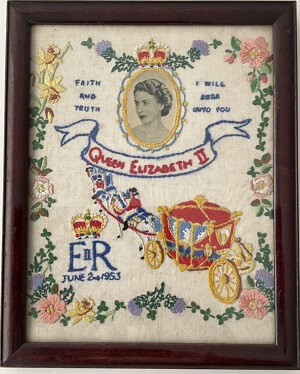
“When the king died and we had a queen there was talk of a new Elizabethan age. My sister got a magazine which I think was called ‘The young Elizabethan’. I remember nothing of the coronation itself. We lived in Yorkshire and London, and any celebrations, seemed so far away. The main impact was the free apple, not something we had normally, and the mug. As children we all (four of us) had a glass of milk every day in silver mugs. When we got our coronation mugs we used them for our daily glass of milk. We could distinguish who each mug belonged to because they were not well made and all had different fault marks on them.
I was 12 when I embroidered the sampler. My grandmother bought women’s magazines and when finished she would send them to my mother. Postage was more reasonable in those days. I had no say in the decision to send for the samplers. I can’t remember being particularly excited as it was a time when I just did as I was told. I wanted my mother to buy a second magazine so I could have a decent picture of the queen to use. She refused ‘waste not want not’!”
CORONATION
Preparations for the Coronation were made on a grand scale at an estimated cost of £1.5m (about £44m in today’s money). The Coronation route was 7.2 km long and took 16,000 participants two hours to complete. The idea was to ensure as many people as possible could witness the event. There were 29,200 military participants drawn from all parts of the armed forces and 7,000 police were drawn from 75 provincial forces to assist the Metropolitan Police and the Military Police. The crowds came out, even though it rained heavily.
For many people, notable memories of this occasion include the invention of a dish called Coronation Chicken, chicken curried in a creamy sauce, and the news that Sir Edmund Hilary and Sherpa Tensing Norgay had scaled the world’s highest mountain, Everest, on 29 May, news which reached the UK on Coronation Day. Hilary received a knighthood and Tensing Norgay, the George Medal for this feat, dubbed a Coronation gift. Meanwhile, the hit of the day was undoubtedly Queen Salote of Tonga who refused protection from the pouring rain because it was Tongan custom that one did not imitate the actions of the person one was honouring. The crowd loved her.
Mary Bradfield played a key role in the celebrations:

“At the time of the Coronation I was 18 years old and working for Constance Spry the florist who was given the job of designing the flowers for the banqueting tables following the coronation. There was a luncheon at Westminster Hall and the coronation dinner at Lancaster House.
The flowers on the tables at Lancaster House were in gilt and crystal bowls with swags of flowers on the walls. I remember we started work at 6am and wore pale rose pink overalls. We were allowed to see the tables when they were finished and I remember that the cutlery was gold. The photo shows Constance Spry putting the final touches to the tables. Not only did Constance Spry design the floral arrangements but she also proposed a recipe of cold chicken in the curry sauce. This was accepted and has since been known as Coronation Chicken.
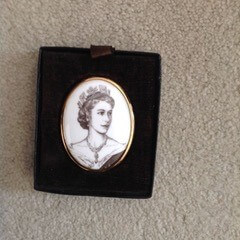
As a memento of the day Constance Spry presented each one of us with a brooch showing a picture of the Queen.”
A number of local residents today remember their trip into London to watch the event. Ernest Newhouse remembers:
“At the time I was 15 years old and lived in Wembley Park. With a school friend I took virtually the last tube train on the previous evening and went into London. We found a place to watch the procession after the ceremony, a bit above the curve in Regent Street, and sat on the pavement through the night.
At about 6 in the morning, the police made us stand up even though the procession would not come through until the afternoon.The crowd around us was very good tempered and in due course we had a very good view. At some point, probably in the morning, the news of the ascent of Everest came through which cheered us all up.
I cannot remember what we did about food, but I imagine we had brought our own supplies. Nor can I remember what we did for toilet facilities. Had there been a problem, it would probably have stuck in my memory. I do remember that the day was punctuated with heavy rain, but fortunately we had come prepared but I don’t think we were allowed to put up umbrellas.When the procession went by – and it took a long time to pass, Queen Salote of Tonga (“Linger longer Queen of Tonga”) won universal admiration for not using her umbrella.
We went home very tired but very happy.”
Margaret Sherlock recalls:
“At the time of the Coronation in 1953 I was aged 15 and at a grammar school in Hillingdon. All the schools in Greater London were allocated a place on the Victoria Embankment which was reserved for schoolchildren. Our school had about 30 places and there was a draw. I was lucky enough to get a place. We were taken by train from Uxbridge to Westminster and then made our way to our allocated position. One of the highlights was all having an ice lolly and I also remember the newspaper boards announcing – “Everest Climbed”. After seeing the procession go to the Abbey we were brought back home. We arrived back in time to see the rest of the day on television. I joined my family at the neighbours’ house as we didn’t have a TV at that time. Looking back, I realise how lucky I was to be successful in the draw when we had so few places.”
Monica Sado’s memories are very vivid:
“In the afternoon of June 2 1953 my parents and I left home with sleeping bags and refreshments to catch the London underground to Trafalgar Square. My father had studied the route of the Coronation procession and had decided that near Trafalgar Square was the best place to be as it was part of the processional route on the way to Westminster Abbey.
We waited for hours all night for the big event. There was great excitement in the air and whenever anything passed by – regardless of what or who it was, a great cheer went up.
In the early hours of the morning of 3 June we heard the news that Edmund Hillary and his sherpa Tenzing Norgay had been the first explorers to reach the summit of Mount Everest on May 29 – that brought a huge cheer (news took much longer to reach us in 1953).
I always recall that sometime later there was a great cry of ‘Oh No!’ from a lady standing near me – a pigeon had just anointed her.
Eventually the time came for the procession and it was raining quite heavily. A cheer went up for every carriage as it passed; all the carriages had closed tops until Queen Salkote of Tonga came in an open topped carriage – a huge cheer went up for her and she waved to the crowd with great enthusiasm.
Finally came her Majesty the Queen looking radiant in her golden coach.
Once all the procession had passed my parents and I caught the underground home where we arrived before the Queen reached Westminister Abbey. Our television was turned on to watch the Coronation Ceremony but I was so tired I could not stay awake!!!”
Kevin Beaumont remembers:
“We were living on White Lion Road at the time of Queen Elizabeth’s coronation; I was a few days short of my 6th birthday. My father bought a large Union Flag and draped it from my brother’s and my bedroom window for a few days. My younger brother had measles and so had to stay in bed, but Dad and I set off straight after breakfast, walked the mile to Chalfont & Latimer Station and took the train to Baker Street. I imagine that we must have taken the tube from there but my main memory of the journey is that a lot of walking was involved to get to our stand-point on the route of the procession, in Oxford Street.
The size of the crowd was overwhelming for a small boy unused to the city but everyone was very friendly and happy to wait patiently; I think that Dad bought us both an ice cream. Someone produced some wooden chairs, presumably from one of the shops, and I and other children were lifted up to stand on these, so that we could see over the heads of those in front of us. My father produced a box periscope and I had an excellent view when the procession eventually rode past in all its glory.
I remember little of what we did after the procession had gone past but I vividly remember us going into the Fullers grocery shop, which stood on the corner of Cokes Lane, on the way home, to buy an iced walnut and cream sponge cake for tea – something my father always did on special occasions.”
Like many other people, for Jill Mace it was an exciting opportunity to watch the events on television:
“I lived in Harrow at the time of the Queen’s Coronation. I was 10 years old and lived in a flat in a small cul-de-sac. Only one lady in the road, Hilda Giddings, had a television set and I had never seen one. It was about 9 inches wide but was enhanced by a magnifying screen in front of it. Everyone from the road piled into Hilda’s living room to see the wonderful event. I remember it being quite magical. After the Coronation we went round to the local hall. We had a tea party and the children put on a play very loosely based on the Coronation.”
Liz Chalmers played a role in an earlier royal event:
“I am old enough have a souvenir programme for the coronation of Queen Elizabeth II and a book, written by Richard Dimbleby, given to school children then. I was part of a guard of honour on the Greenwich Town Hall steps when the Queen brought Prince Philip to Greenwich to install him as Baron Greenwich of Greenwich. My memory of the Queen was that she was tiny and what bright blue eyes she had.”
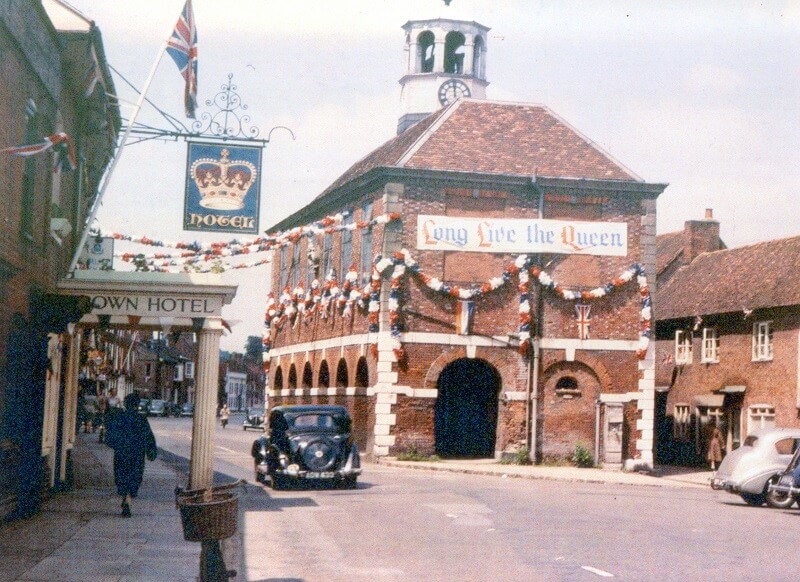
AMERSHAM
In Amersham, suitably majestic plans for celebration were debated by the Council in November 1952 and you can read about them here For some older residents, this was the fourth Coronation that they had experienced.
In February 1953 some dissension was reported when the Rector of St Mary’s Church declined a request from the Committee to take part in a civic Coronation service which was not conducted in the Parish Church.
In his view, the Coronation was a Royal Proclamation of the Church of England. As the Church of England was the church of this country maintained that the civic service should be held in the Parish Church and he would take part in no other. He acknowledged that Free Church ministers could not take part in a service in the Parish Church.
Ambition was high, but sadly support for the pageant was not forthcoming.
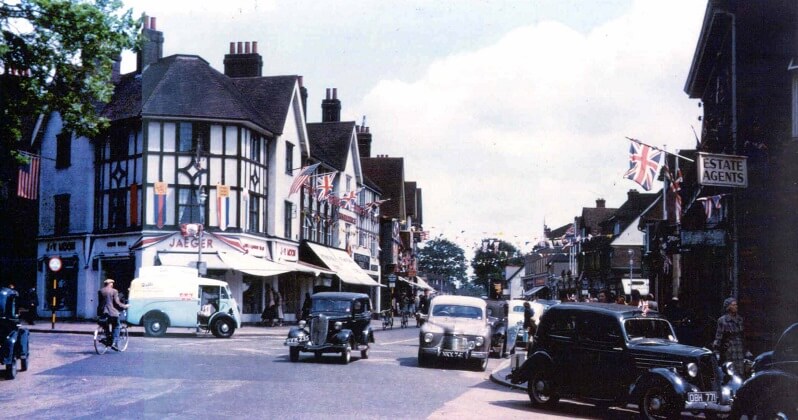
CORONATION PAGEANT CANCELLED
At a meeting of the Coronation Committee in March 1953, it was reported that the procession and pageant planned as part of Amersham’s Coronation celebrations had been cancelled through lack of support.
The committee chair reported that 120 letters seeking support had been written but only 4 replies received. One was a postcard offering a top hat, another from a mother who said her young son would ride a pony and an offer from the Headmaster of the Grammar School. The Women’s Institute had declined to give support. Only £137.13.10 had been raised by local subscription.
Much discussion ensued in the following weeks and the reason for the lack of support was identified as the appearance of television.
One committee member observed “10% might go to London and out of the remaining 90%, 45% would want to stay at home on June 2nd and watch television. I feel we have a duty towards those people who have no television. The proper thing to be singing on that day is Rule Britannia, not Rule be Television!
Reports from the various committees were more positive. The Sports Committee confirmed all the Children’s Sports had been organised, within the budget of £30; the Street Decorations Committee had decided to offer prizes for the best decorated houses and limit bunting decoration to the area being used for dancing; The Dancing Committee had obtained a caller to assist with the dancing, using the British Legion hall in the event of rain, and had obtained song sheets for community singing. The Catering Committee had arranged with a firm of caterers to provide a meat tea for 140 old folk and a 2/4 tea for 1,200 schoolchildren on May 30th. The Publicity Committee were struggling to produce their souvenir programme (but in the event, it was published and copies can be viewed in Amersham Museum.)
Photographs of the time reveal that street decorations were still in favour.

Other ideas were shared.
During the discussion upon the proposed Amersham Coronation Festivities the matter of dancing in the street was mentioned, an idea which seemed to find favour as an easily arranged and enjoyable function if the weather was good Such a matter would have to lie arranged with the authorities and the police who control such matters would have to give the necessary permission. From the audience there emanated the idea that if wet it was possible that the dance could be transferred to Amersham Bus Garage This is a more doubtful matter. It is a query whether there would be room for such an event on account of the number of buses they have to house.
The Coronation was the theme at the last social of the season at Amersham Common Recreation Hall on Thursday Nearly 90 people joined in the fancy dress of popular song titles the winners of which were Mr and Mrs Magee who tied for first place, Mr Magee dressed as the “Blue Bells of Scotland “ and Mrs Magee “How much is that Doggie in the Window?” All prizes given were souvenirs of the Coronation.
THE PEOPLE ENJOYED THEMSELVES
Despite all the caprices of the weather Amersham was determined, like many other places throughout the country, to celebrate the Coronation come what may.
ARMY CADET FORCE
Coronation Day started early with the local company of the Army Cadet Force for at their Headquarters early members of the Company had paraded with members of the Amersham Hill Branch of the British Legion for the raising of their country’s Standard to the mast that had been erected at their respective Headquarters in Woodside-road .
BARROW BOYS OF OLD AMERSHAM
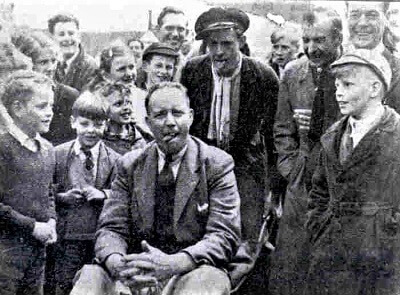
Watched by an admiring crowd gathered in the High-street Old Amersham on the morning of Coronation Day sixteen variously attired males and eight wheelbarrows, one passenger and one pusher to each barrow, raced from the Swan Inn to the Nags Head in Whielden Street . A condition of the race was that the competitors should take refreshment at each of eight inns and hotels en route, passenger and pusher changing over at each visit. The winners were temporary barrow bovs George Langridge and Albert Gladman.
THE INFIRM AND THE VETERANS
Over a hundred people aged infirm war veterans of all creeds were the guests for the day of the Amersham Chesham and District Hebrew Congregation at Woodside Hall where they enjoyed the magnificent spectacle of television’s broadcast on a large 4 ft by 3 ft screen kindly lent to the congregation by Mr Harold Bowman The whole of the seating accommodation of the hall was offered by ticket to the Amersham Council for them to distribute as they thought fit for people who had no set of their own and no opportunity to see the broadcast The community supplied all the food for the day from coffee and biscuits on arrival to lunch and tea with cold drinks always available A lovely Coronation cake was cut and a drink supplied with which to toast Her Majesty’s health Not least of the striking features of the show was the beautifully decorated hall the stage being surrounded by red white and blue geraniums while the comfortable chairs on which the viewers sat for hour after hour were lent by the St John Ambulance Corps
THINGS SPRING TO LIFE
The afternoon was quiet and the streets of Amersham deserted while the people listened in or looked in but things came to life once more and probably most fittingly it was brought to life by about 200 people for whom this was the fourth Coronation of their memory For that was the number of over 65s who came to Goya’s Canteen for the Coronation Day meat tea provided once more by the Amersham Parish Council.
THE OLD TYME CRICKET MATCH

This Match, held in Barn Meadow, where cricket has been played for over 120 years, will demonstrate the manner in which the game was played in those early days.
The Players will wear period dress with top hats, white trousers and black boots. The wicket will be smaller (the third stump was added in 1775) and bowling will be underhand. ………..bats are being specially reproduced for the match. They are curved, rather like a broad hockey stick.
It was shortly after 6 pm that the first ball underarm was bowled in the match in which the Fencibles entertained Amersham Hill Our photograph shows what sort of a match it was for the Gentlemen on the field and at the wicket played the game as it was first played on Barn Meadow 120 years ago The collection of bewhiskered and top-hatted gentlemen put on a wonderful show which when Amersham Hill had been dismissed was unfortunately brought to a close due to a familiar Old Trafford expression “rain stopped play” Doubtless however rain stopped play on Barn Meadow 120 years ago so tradition was equally well observed.
DANCING
And so commencing at 8 pm or thereabouts Amersham moved on into what their programme said was “one of the most ancient traditional forms of public celebration” dancing which owing to the almost continuous evening rain was held not in the High-street but in the Council Chamber Into this normally dignified atmosphere crowded scores and scores of people to watch the Scottish Association giving demonstrations of their national dances and other demonstrations by the Chiltern Youth Club and the Amersham Folk Dance Club so enthusiastically that it seemed as if the whole place might collapse. The revellers joined in the community singing led by the impressive singing voice of Mr Donald Kingston and at every excuse sang their very hearts out.
THE CHILDREN
Saturday in Amersham was the children‘s day without a doubt. About 900 of them supplied over 1100 entries for the sports held in Barn Meadow in the afternoon. Organisation was at a high standard to cope with such a terrific task a task of dealing with the 127 races necessary to reach twenty-eight finals Children of any age up to 16 were able to compete in races which ranged from 40 yards for the under 6s to 220 yards for the under 16s boys and girls and the prizes that the successful ones were able to win included cups 50 medals and 50 coronation spoons………..
Once the sports were over came the tea provided by the Parish Council for all the youngsters. This immensely popular event (!) was the curtain raiser put on for a variety concert which entertained them all for two and a half hours and included the Chesham Bois Scouts with a grand acrobatic show the group of Chesham entertainers under Mr Bill Ames and a great favourite the Marlow conjurer Mr Tony White So ended the children’s day of the Amersham Coronation festivities and there were many scores of tired and happy youngsters for whom it will be a most memorable day.
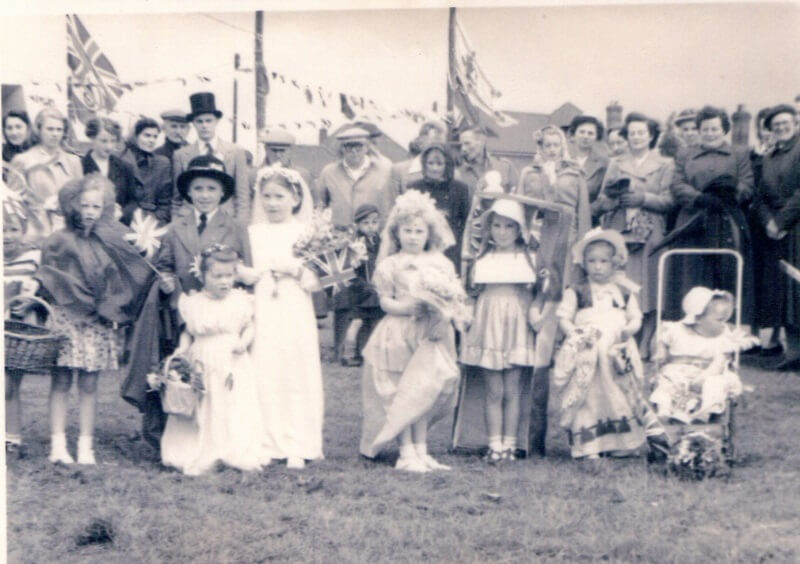
WINCHMORE HILL
Winchmore Hill was not to be outdone and 400 people turned out for the festivities up there. Fancy dress featured strongly with the children proudly displaying a range of costumes.

Here is the procession making its way up the Hill to the Common
Finally the adults joined in the fun with these intriguing shots of cross dressing on the Common! Claire Adams explains:
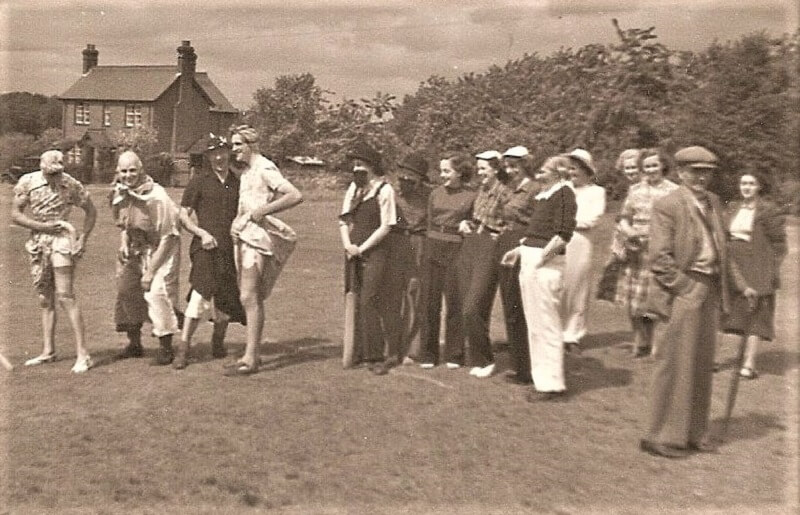
“This is a coronation picture of my grandmother (Hilda Adams) who lived at Royal Cottages in Winchmore Hill. She is the lady on the right.
Sadly I don’t have any details just that I know the women dressed as the men and men dressed as the women!”
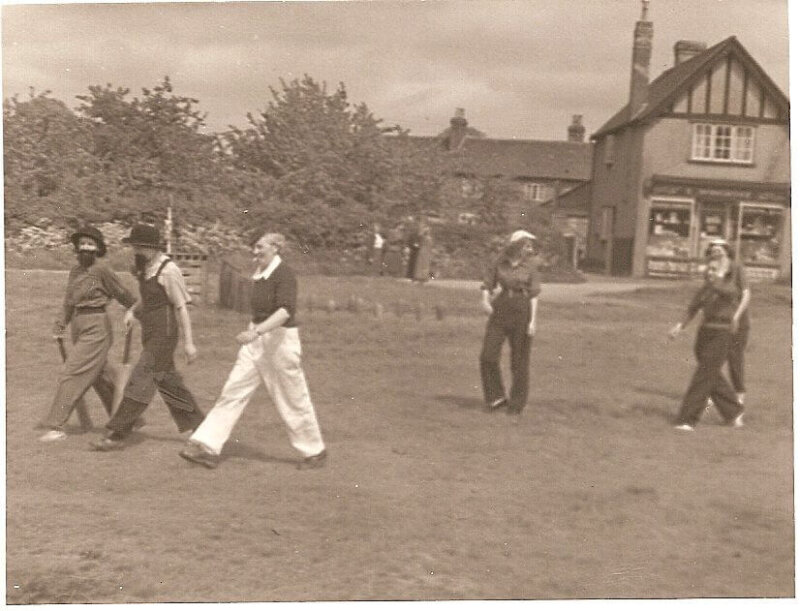
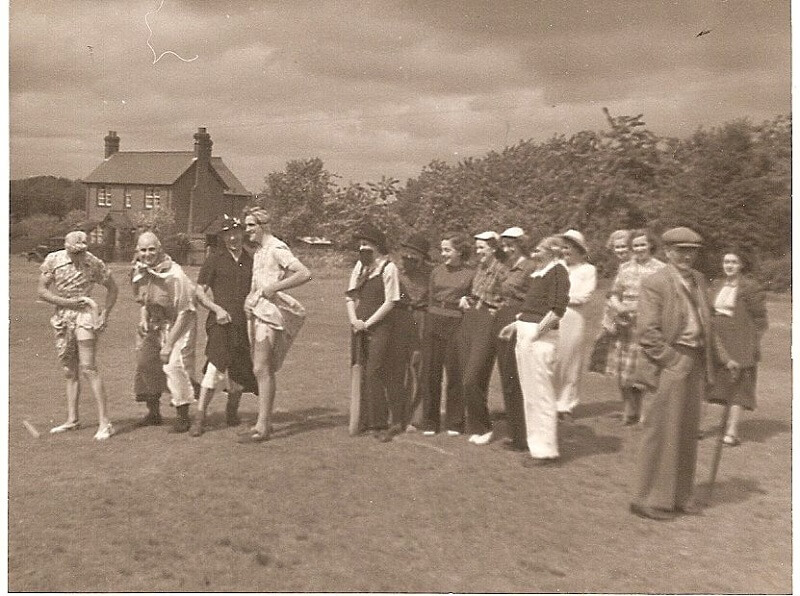
Wendy Payne remembers
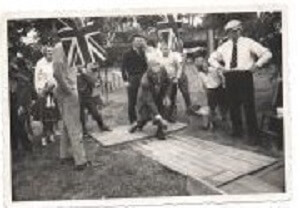
“I was 17 years old at the time of the Queen’s Coronation. I was working in the Co-op Store in Chesham. We were not allowed to have the day off which I was very disappointed about. In the evening there was a dance at Winchmore Hill Village Hall and it was there that I met my husband. I have a picture of my dad playing bowls on Winchmore Hill common on Coronation Day.”

